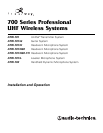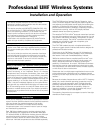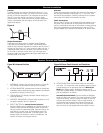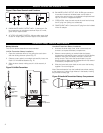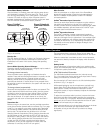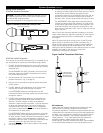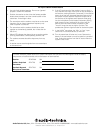
5
T
ransmitter Setup, Controls And Functions
Figure F-UniPak
®
TransmitterTop View
Figure G-Handheld
Transmitter Bottom
View
Input Connector
P
ower Switch
Power/Mute/
Battery Indicator
Antenna
Power Switch
P
ower/Mute/Battery Indicator
After the battery is installed, press and hold the power button
until the battery indicator LED turns green (Fig. F & G). (It will
turn red first; keep holding until it turns green). If the battery
indicator LED does not light up when the power button is
p
ressed, the batteries are installed incorrectly or they are dead.
The LED will flash to indicate low-battery condition.
Mute Function
With the transmitter on, a slight touch of the Power/Mute
button will toggle between muted and unmuted operation.
Red LED indicates muted operation. Green LED indicates
unmuted operation.
UniPak
®
Transmitter Input Connection
Connect an audio input device (microphone or guitar cable) to
the audio input connector on the top of the transmitter. A
number of Audio-Technica professional microphones and cables
are available separately, pre-terminated with a UniPak
®
input
connector (see www.audio-technica.com.)
UniPak
®
Transmitter Antenna
T
he UniPak
®
t
ransmitter includes a permanently-attached
flexible antenna. For best results, allow the antenna to hang
freely and full length from the transmitter. If the received signal
is marginal, experiment with different transmitter positions on
your body or instrument; or try repositioning the receiver. Do
not attempt to remove, replace or change the length of the
transmitting antenna.
System Operation
Plug in the receiver.
Receiver On…
The LED display will light up. If either A or B diversity indicators
lights up at this point (without transmitter on) there may be
interference in the area. If this occurs, change the operating
channel.
How to Make Operating Channel Changes
Operating channel changes (frequency changes) may be made in
two ways: manually and automatically.
To change channel manually
Press the Select button repeatedly until desired channel is
reached. Press and hold the Set/Scan button to manually set the
receiver to indicated channel. Channel number will stop
flashing. (A brief touch of the Set/Scan button will revert to
previously set channel). If the Set button is not pressed within
10 seconds to confirm the selection, the system will revert to its
original channel.
To change channel automatically
Press and hold the Set/Scan button for about two seconds.The
current channel will flash three times quickly; then the system
will begin to scan for the next open channel. When it finds an
open channel, it will flash the open channel three times and
then set the channel. (If an open channel is not found, the
automatic scan will return to the original channel and flash 5
times.)
Transmitter On…
Before turning on the transmitter, use the provided screwdriver
to set the transmitter channel selector switches (Fig. D on page
4 and Fig. H on page 6) to the same number that is displayed
on the receiver. Select channels 1-8 (channels 9 and 0 are for
service use). The transmitter may be either on or off when
changing channels (frequencies). When changing channels with
the transmitter on and unmuted, the LED will turn red as the
adjustment is being made; it will turn green when the channel
is set. (When changing channels with the transmitter on and
muted, the LED will remain red during and after channel
adjustment, as long as the transmitter is muted; when the
transmitter is unmuted, the LED will turn green.)
The transmitters have a soft-touch Power Switch. When the
transmitter is “on,” the transmitter produces both RF and audio.
When the transmitter is switched on and in normal operation,
the receiver's diversity indicators will display which antenna is
active.
Setting Levels
Correct adjustment of transmitter audio input, receiver audio
output, and mixer/amplifier input and output levels is important
for optimum system performance.
ATW-T702 HandheldTransmitter
The 700 Series handheld transmitter trim (volume) control
(Fig. H on page 6) has factory pre-set audio input levels. Factory
setting is full clockwise, maximum gain.
Set the receiver's AF Level control to its full clockwise position
(maximum). (Fig. C on page 4).
While speaking/singing into the microphone at typically loud
levels, check the AF peak indicator on the receiver. If the AF
peak indicator is easily illuminated and distortion is heard
through the system, it may be necessary to adjust the transmitter
audio input level.
To adjust the transmitter audio input level, unscrew the lower
body cover and slide it downwards, exposing the screwdriver
and trim control (Fig. H on page 6). Remove the screwdriver and
gently
turn the trim control counterclockwise until the AF peak
indicator is illuminated only on audio peaks.
Return the screwdriver to its clip and close and secure the lower
body. No further transmitter gain adjustments should
be needed, as long as the acoustic input does not change
significantly.
P
ower/Mute/
B
attery Indicator



